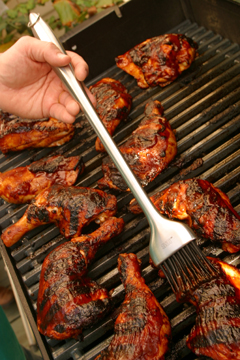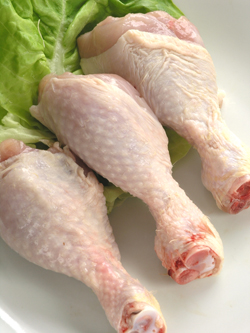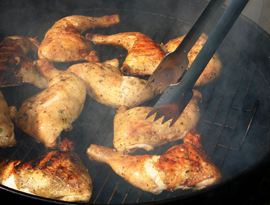How To Make Barbecue
Page 4: Cooking A Barbecue Chicken
This is Page 4 of a seven page article. Click on the black links below to visit other pages.
Cooking Barbecue Chicken & Other Meats
Barbecue Meat Cuts
Probably the most popular and easiest meat to prepare for friends and family on the barbecue is chicken. As an appetizer on skewers or as the main course, chicken is simple and delicious with a few basic tricks. Chicken is also relatively cheap, making it a great meat to practice and experiment with and eat the results without waiting for hours.
While our focus today is chicken, here’s a quick word about the other BBQ meats, pork and beef, which fall into two very distinct groups based on tenderness.
- Classic barbecue cuts include beef brisket, chuck roll and pork shoulder. These cuts are inexpensive because they are fibrous and tough and need to be cooked for a long time to tenderize them—but once the fibers are broken down by cooing, the flavor is delicious and more flavorful than pricier cuts. You can’t serve (or chew) these cuts with some pink in the middle: the only way to get them tender is to break down the connective tissue by cooking them to an internal temperature of 190ºF to 200ºF. This means the meat is definitely well done.
- Tender cuts, which are more expensive, include whole top sirloin, whole rib eye, tri-tip, prime rib, pork tenderloin and filet mignon. These are the cuts to consider if you want some pink or red meat or just want the horns knocked off. They do benefit from cooking indirectly with wood smoke. As tender cuts don’t have connective tissue to break down, which adds flavor and moisture, cooking indirectly at a hotter temperature of 300°F to 350°F helps to preserve the moisture.
Technique
Temperature Targets
- Chicken: White meat, 165°F; Dark meat, 175°F (although these are the safe temperatures you may need to go higher to get the blood cooked out of the joints)
- Beef: Rare, 125°F; Medium rare, 135°F
- Pork: 150°F
Tough cuts such as beef brisket and pork shoulder need to be cooked to 190°F to 200°F and for a long enough period to allow the connective tissue to break down.
Resting And Bounce
Resting is in the arsenal of the classically trained chef and helps every cut of meat. Even a drumstick rested for 10 minutes is better than straight off the grill. Resting allows the juices in the meat to redistribute.
 Bounce is where the cooking temperature and the outside of the meat is significantly higher than the core temperature of the meat. When you take the meat of the heat and rest it, the core temperature rises as the higher outside temperature works it's way to the core. Allow for this by polling at 5° to 10° lower than you desire or dropping the cooking temperature as you get to your desire internal temperature. Bounce is where the cooking temperature and the outside of the meat is significantly higher than the core temperature of the meat. When you take the meat of the heat and rest it, the core temperature rises as the higher outside temperature works it's way to the core. Allow for this by polling at 5° to 10° lower than you desire or dropping the cooking temperature as you get to your desire internal temperature.
Tough cuts such as beef brisket can get to the target temperature of 195° to 200°F and still be tough because the connective tissue has not broken down. In this case wrap in foil and hold at 200°F until the meat gets tender. Also if using a leave-in thermometer, expect to reach a plateau where the heat going into the meat is breaking down the connective tissue and the temperature will stall around 165°F for an extended period.
This handsome, stainless steel basting brush with heat-resistant silicone bristles is ideal for barbecues. from William Bounds, $14.95. Click here for more information or to purchase.
Here’s how we’d prepare the perfect barbecued chicken.
Choosing Your Chicken
 Fresh. Fresh is wonderful as a place to start a recipe that involves marinating or brining. Without the help of marinating or brining, fresh chicken is very easy to overcook and does not hold well, resulting in unappetizing, dry chicken. Kosher chicken has already had salt added and can be considered brined. Fresh. Fresh is wonderful as a place to start a recipe that involves marinating or brining. Without the help of marinating or brining, fresh chicken is very easy to overcook and does not hold well, resulting in unappetizing, dry chicken. Kosher chicken has already had salt added and can be considered brined.
Chicken Broth Added. Our favorite type of chicken to buy for the barbecue has chicken broth added. The label will say “X% chicken broth added.” This kind of chicken requires no prep and is very forgiving to cook and hold. Two common brands of this type are Tyson® and Purdue®. We normally use Tyson®, which is widely available. You can use the Not so Basic Brine (recipe below) on broth-added chicken; just use half the salt when making the brine.
If you have fresh chicken without broth added, soak the chicken for 12 to 48 hours in the refrigerator in Not So Basic Brine, or marinate overnight. Bottled Italian salad dressing is a favorite marinade of competition barbecue cooks.
Whole Or Pieces?
The benefits of cooking individual pieces:
- The rub and the smoke evenly cover the entire piece of the meat.
- Cutting up whole chickens takes time, so pieces cut up by the grocery store win on the convenience factor.
- White and dark meat cook at a different speeds, so you can pull each piece off when it’s ready.
Benefits of cooking whole birds:
- Whole birds take up less room on the grill than individual pieces.
- Whole chickens provide an impressive “WOW!” factor when presented at the table.
Whole chickens cook best if the spine is cut out with kitchen shears or a sharp knife and the bird is pressed flat, a.k.a. butterflying or spatchcocking the bird. Opening up the bird gets smoke and rub to both sides of the meat.
One of the last places to get cooked (no visible blood) is the leg-to-thigh knee joint. Popping the knee by overextending the leg-to-thigh joint makes for more even cooking. Fold back the wings.
Seasoning
Up to two hours before cooking, apply your favorite seasoning or rub liberally to the chicken (see our Basic BBQ Rub recipe, on the next page). One of the best ways to make super-flavorful chicken is to gently separate the skin from the meat and rub the spices directly on the flesh. The trick is to not break the skin when doing this!
Apply rub to all sides of the chicken. Individual pieces have the most surface area to absorb smoke flavor and for the rub to stick to. The best and easiest way is to toss the parts with rub in a large stainless mixing bowl. Again, peeling the skin back so the rub is directly on the flesh and then rolling the skin back over the rub improves flavor.
How To Keep Chicken From Burning
The secret to perfect barbecue chicken is to avoid putting raw meat directly over high heat.
 In a charcoal grill, bank the fire at the outside edges and cook the chicken in the middle of the grill. In a charcoal grill, bank the fire at the outside edges and cook the chicken in the middle of the grill.
- On a gas grill with a single burner, keep the flame as low as possible to achieve temperature.
- On a gas grill with two or more burners, just light one burner and place the chicken over the unlit burner.
Add your favorite wood for smoke flavor (we prefer cherry or apple wood for chicken). With the lid down, ideal grill temperature is 300°F to 350°F. The goal with the lid down is for a light blue smoke trail to waft from the cooker.
When Is It Done?
Boneless pieces can be cooked in approximately 20 to 30 minutes; bone-in pieces take 30 to 45 minutes. If you are cooking whole chickens, try not to peek for the first 45 minutes to an hour. After an hour you are looking for internal meat temperatures approaching the final internal temps of 165°F for white meat and 175°F for dark meat (referred to as safe or proper temperature).
- Cook the chicken skin side up until temperature is reached. The thermometer should not touch the bone when taking a reading.
- When cooking whole chickens or hind quarters, there should not be blood when you cut into the wing-to-body joint and the leg-to-thigh joint. These joints are the last two places to reach a safe temperature.
- Some pink on the outside of the meat is normal. This is caused by charcoal and wood smoke, although this smoke ring can freak-out newbies to smoked food.
Crisping The Skin
After the chicken has reached its proper temperature, you can crisp up the skin by turning the chicken skin-down over higher heat. Check every thirty seconds, as it is easy to burn the skin. Once the chicken skin is crisp and the chicken has achieved the desired temperature, you can glaze and finish with cool fire (225°F with the lid down) and the meat away from the heat; or remove from the heat and serve with sauce on the side.
Enjoy!
Continue To Page 5: Brine & Rub Recipes
Go To The Article Index Above
Lifestyle Direct, Inc. All rights reserved. Images are the copyright of their respective owners.

|